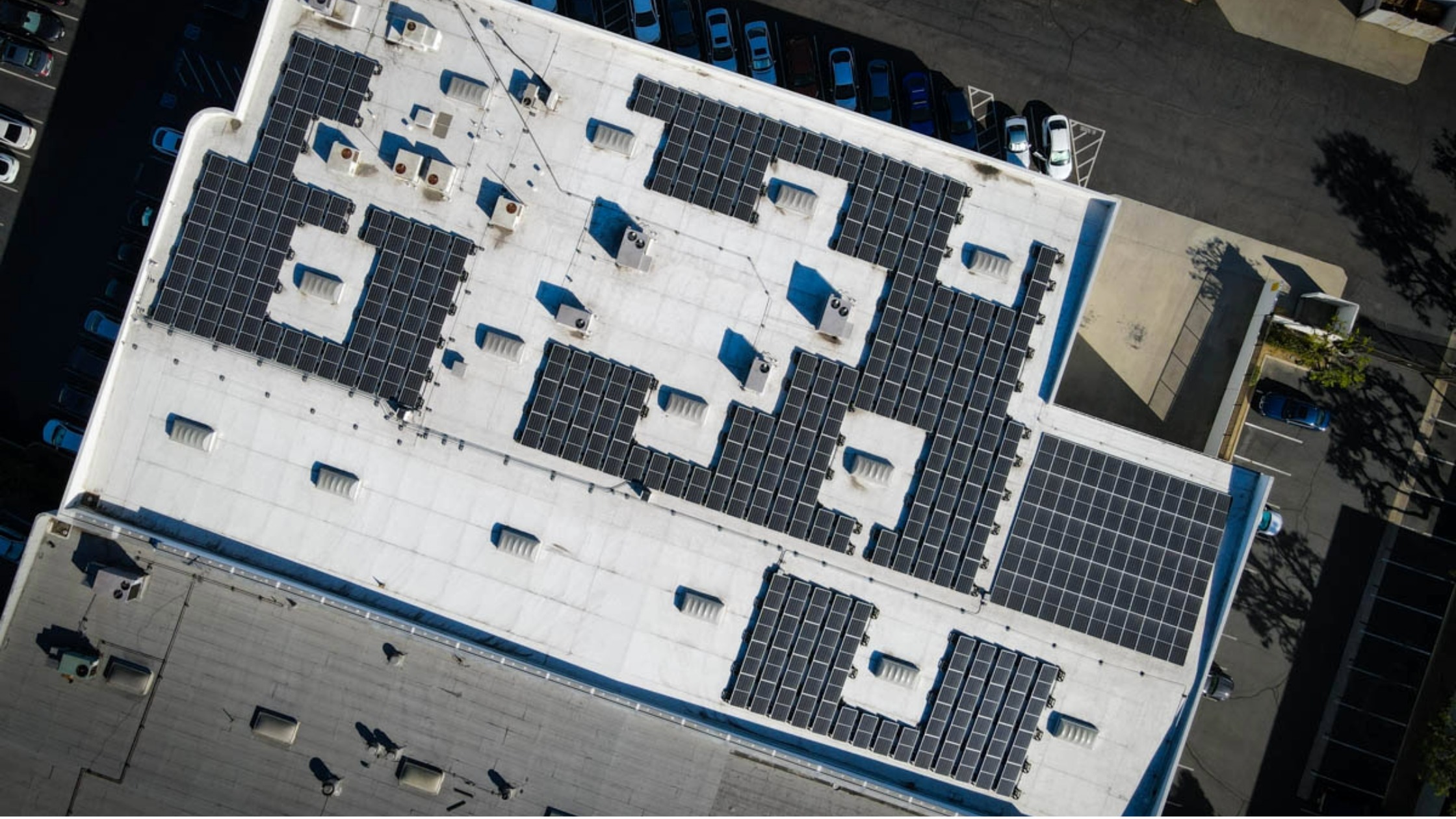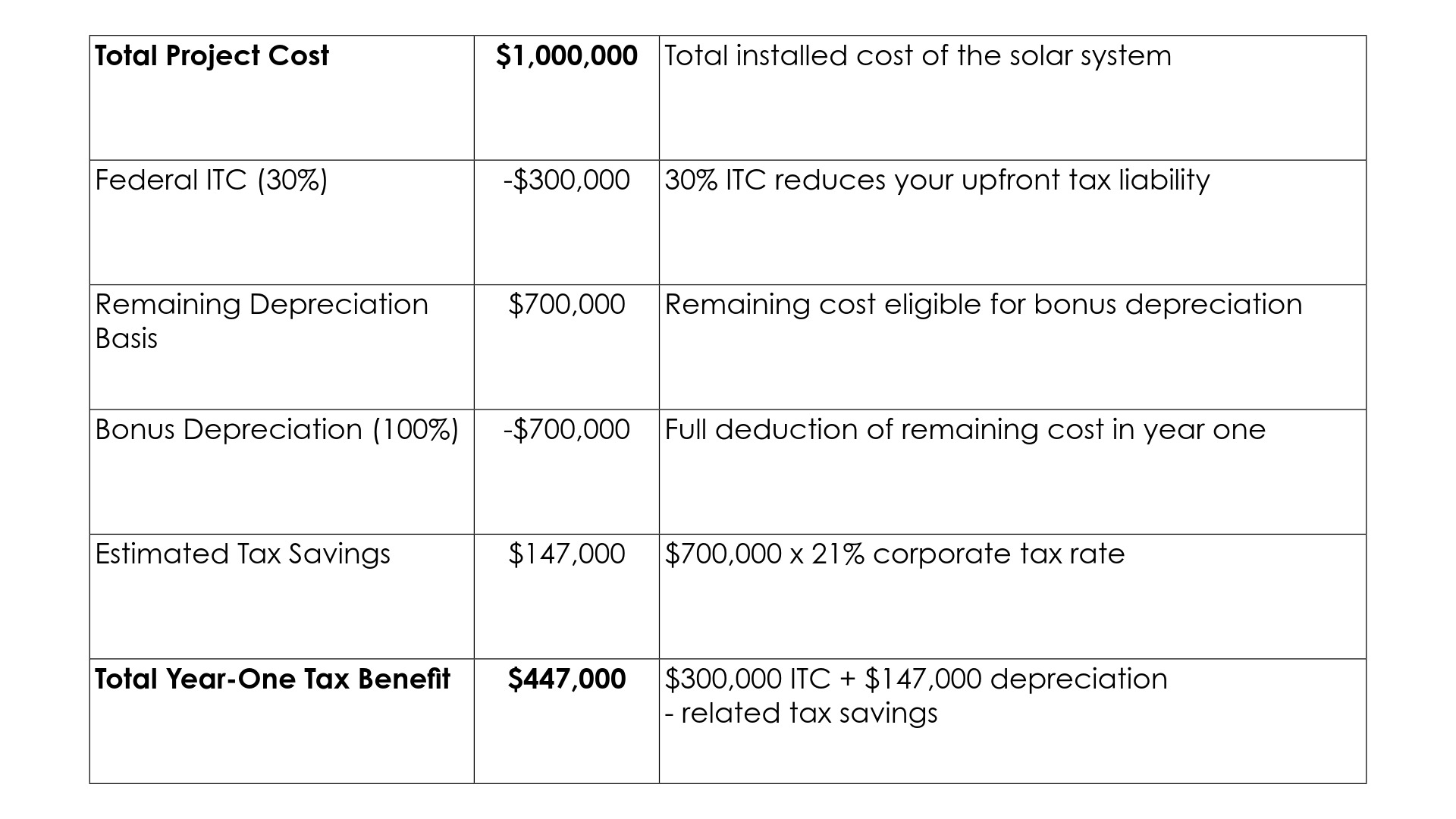100% Bonus Depreciation Is Back for Commercial Solar in 2025 — But the Clock's Ticking

TL;DR: The One Big Beautiful Bill (OBBB) or HR1 restored 100% bonus depreciation for commercial solar projects placed in service after January 19, 2025. Combined with the 30% Federal Investment Tax Credit, business owners can recover nearly 45% of their solar investment through first-year tax benefits. However, project timelines and supply chain delays mean you need to start planning now to meet the qualification requirements.
Big news for commercial property owners: one of the most valuable tax breaks for solar just got stronger. Thanks to recent federal legislation, 100% bonus depreciation is back for solar projects, and it's creating one of the best financial opportunities we've seen in years.
If you've been thinking about solar for your business property, this could be the push you've been waiting for. But here's the thing — the window to take advantage of these benefits is tighter than you might expect.
What Is 100% Bonus Depreciation for Commercial Solar?
Bonus depreciation is a tax rule that lets businesses write off the full cost of qualifying equipment in the year it's installed, rather than spreading those deductions over several years.
For commercial solar, this means you can immediately deduct 100% of your eligible solar equipment costs against your taxable income. When you stack this with the 30% Federal Investment Tax Credit (ITC), the financial impact is incredible.
Here's a quick example: Install a $1 million solar system, get a $300,000 tax credit through the ITC, then deduct the remaining $700,000 from your taxable income in year one. The result? Massive upfront tax savings that can recover nearly half your solar investment through first-year tax benefits.
How Does HR1 Change Commercial Solar Tax Benefits?
Before HR1 was signed into law, bonus depreciation was on a downward slide. It had dropped to 40% in 2025, eventually disappearing entirely.
HR1 hit the reset button, bringing bonus depreciation back to 100% for qualifying projects placed in service after January 2025. According to the Internal Revenue Service, this provision is technically permanent for property placed after this date, but smart business owners aren't waiting around to take advantage of it.
Why not? Because solar projects take time, and there are plenty of factors outside your control that can delay your timeline.
Why Should Commercial Property Owners Act Now?
Here's the catch: your solar system needs to be installed and operational — what the tax code calls "placed in service" — after January 19, 2025 to qualify for the full 100% bonus depreciation. That means your system needs to be generating power, not just ordered or partially installed.
Commercial solar projects aren't like buying a new computer. They involve multiple phases that can each take weeks or months: site assessment, system design, permitting with local authorities, utility interconnection approvals, equipment procurement, and installation.
And here's where it gets interesting — as more business owners catch wind of these enhanced tax benefits, we're already seeing increased demand for solar installations. This surge is creating bottlenecks everywhere: permitting offices are backed up, utility interconnection queues are getting longer, and equipment suppliers are struggling to keep up.
Projects that might have taken four months to complete could easily stretch to six or eight months as the industry scales to meet demand. We've already had clients who started their projects in early 2024 just now getting their systems turned on.
The lesson? If you're thinking about solar, starting your planning process now isn't just smart — it's essential to ensure you don't miss out on these valuable incentives.
How Much Can You Save With 100% Bonus Depreciation and the 30% ITC?
The combination of the 30% ITC and 100% bonus depreciation creates a powerful financial advantage for commercial solar. Here's what this looks like for a $1 million commercial solar installation:

Key Notes:
- Tax savings from bonus depreciation depend on your tax rate. In this example, we used a 21% corporate tax rate.
- Some states don't conform to federal bonus depreciation rules — check with your tax professional.
What Challenges Could Delay Your Commercial Solar Project?
While 100% bonus depreciation is technically permanent for systems placed in service after January 2025, several factors make immediate action crucial.
Supply Chain Constraints: Supply chains are already tightening as demand increases. Solar panels, inverters, and other key components are facing longer lead times, and we're starting to see some price increases as manufacturers struggle to keep pace with demand.
Utility Interconnection Delays: Many utilities are dealing with backlogs in processing solar interconnection applications, which can delay your project's completion by months. We've seen some of our clients wait four to six months just for utility approval.
Local Permitting Bottlenecks: Local permitting offices are feeling the pressure too. As more commercial properties pursue solar installations, permit review times are extending, particularly in areas with limited staff or complex approval processes.
Should You Move Forward With Commercial Solar Now?
The return of 100% bonus depreciation represents a rare alignment of favorable federal tax policy for commercial solar. When you combine it with the 30% ITC, property owners can recover nearly half their solar investment through tax benefits in the first year.
But the window to capitalize on these benefits is more limited than the legislation might suggest. Project timelines, supply chain constraints, and increasing demand all point to the same conclusion: the sooner you start your solar planning process, the better your chances of securing these valuable incentives.
If you've been considering solar for your commercial property, the financial stars are aligned in your favor right now. The question isn't whether you can afford to invest in solar — it's whether you can afford to wait while these opportunities become harder to capture.
Frequently Asked Questions
Q: When does my solar system need to be operational to qualify for 100% bonus depreciation?
A: Your system must be placed in service (installed and generating power) after January 19, 2025 to qualify for the full 100% bonus depreciation benefit.
Q: Can I combine 100% bonus depreciation with the 30% Federal Investment Tax Credit?
A: Yes, these benefits stack together. You receive the 30% ITC as a direct tax credit, then apply 100% bonus depreciation to the remaining system cost.
Q: How long do commercial solar projects typically take to complete?
A: Most commercial solar projects take 4-8 months from initial planning to system activation, depending on permitting, utility approvals, and equipment availability.
Q: Do all states follow federal bonus depreciation rules?
A: No, some states don't conform to federal bonus depreciation rules. Check with your tax professional about your specific state's requirements.
RELATED ARTICLES:
Our Affiliations









